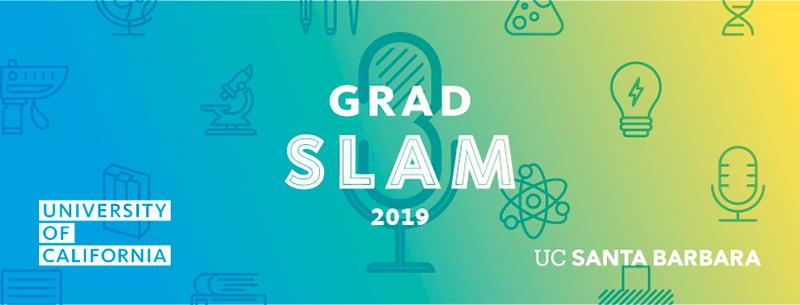Top Stories
Join us as we continue the next stage of the 7th Annual Grad Slam with our second semifinal round! Three students from each semifinal round will advance to the final round happening later this week. Check out a preview of the presentations here and be sure to follow on Facebook for live updates on the winners of each round.

Join us as we âcontinue the next stage of the 7th Annual Grad Slam with our second semifinal round! âThree students from each semifinal round will advance to the final roundâ happening later this week. Check out a preview of the presentations below and be sure to follow on Facebook for live updates on the winners of each round.
SEMIFINAL ROUND 2
Tue Apr 16 | 3-4p
SRB Multipurpose Room
Andrew Steinkruger | Environmental Science & Management
Conservation Opportunities in Commercial Aquaculture: The Case for Farming Totoaba
Crowding out poachers from markets for endangered species products is a difficult, and risky, concept: for charismatic species like rhinos and tigers, ranching has paid off for investors without yielding conservation benefits. The totoaba, an enormous fish endemic to the Gulf of California, offers another story. The species' life history and unique market in East Asia support a growing aquaculture industry. Our group develops a novel simulation model to test the benefits of commercial aquaculture for this remarkable endangered species' survival in the wild.
Bharat Monga | Mechanical Engineering
Cure for Parkinson's: A Dream Come True
Parkinson's disease is characterized by pathalogical synchronization in neuron activity in the patient's brain. An effective treatment can be devised by countering this synchrony. This talk will elucidate treatment for the disease by modeling synchrony in neuron activity in terms of oscillators.
Camille Endacott | Communication
When Artificial Intelligence Makes Your Day
Organizational leaders have entrusted assistants to manage their schedules for some time, but advances in artificial intelligence present new possibilities for how decisions about managerial time are made. Though the outsourcing decisions about one's schedule to humans or artificial intelligence may seem innocuous, these choices have important implications for how managerial attention is directed in organizations. This presentation compares decisions made by human and artificial intelligence related to managers' time and attention and discusses the consequences for organizations and society.
George Degen | âChemical Engineering
Hâealing Muscles with Mussels
The human body and the ocean have a lot in common: both are wet and salty, making them challenging environments for adhesive glues. Nevertheless, marine mussels produce glues that stick to almost any surface under water. My goal is to learn from marine mussels and engineer a glue that sticks to muscle tissue in the body-a mussel-inspired medical adhesive!
Lauren Kaapcke | Environmental Science & Management
Encouraging Investment in Coral Reefs
Coral reefs are effective in protecting coastlines during storm events as well as providing many other ecosystem services, however the total benefits and costs of preserving these ecosystems is not well-documented. My team seeks to encourage investment in reefs by quantifying the benefits and costs so coastal stakeholders can make informed decisions.
Luke Rosedahl | Dynamical Neuroscience
Category Learning and the Human Brain
Categorization is an essential part of the human experience. Every object we recognize, every friend we see, and every car we avoid while driving requires categorization. I will discuss how we study category learning and why it is important.
Margaret Schimmel | Molecular, Cellular & Developmental Biology
Designing the Cure for Polycystic Kidney Disease: A Novel Immunotherapy
Autosomal dominant polycystic kidney disease (ADPKD) is a very common inherited disease classified by aberrant proliferation of renal cells, resulting in the formation of fluid-filled cysts, tissue damage, and eventually kidney failure. This disease affects an estimated 12 million people worldwide and there is currently no effective treatment. With that, I aim to develop a novel antibody that specifically targets renal cysts and effectively blocks cellular growth signaling, preventing the detrimental cyst development characteristic of ADPKD.
Naveen Venkatesan | Materials
"Magic Paint" - Using Hybrid Perovskites for Efficient Solar Cells
Perovskites are poised to revolutionize the solar cell industry by providing a cheap alternative to current technology. By creating an "ink" of perovskite materials and "painting" them onto a surface, one can create a solar cell that is already breaking efficiency records. However, increasing how long these materials stay stable before degrading is a key impediment to commercialization and we hope our research can help solve this problem.
Taylor Heisley-Cook | Environmental Science & Management
âWaste to Wear: Fabric from Cannabis Waste
The biggest impact of any given garment comes from raw material production. MMC fabrics (better known as viscose, rayon, tencel, or modal) are made from wood pulp, which is often unsustainably harvested from Indonesian old-growth forests. I am developing a technique to convert cannabis waste -- millions of tons of which is currently being burned or sent to landfill each year -- into MMC feedstock pulp.
Yvonne Diaz | Chemistry
One Fish, Two Fish, Red Fish? Dead Fish! : Combating Food Spoilage with Color
Colors are beautiful, but they can also be powerful. My research aims to produce color-based sensors that will help address the world-wide issue of food spoilage.